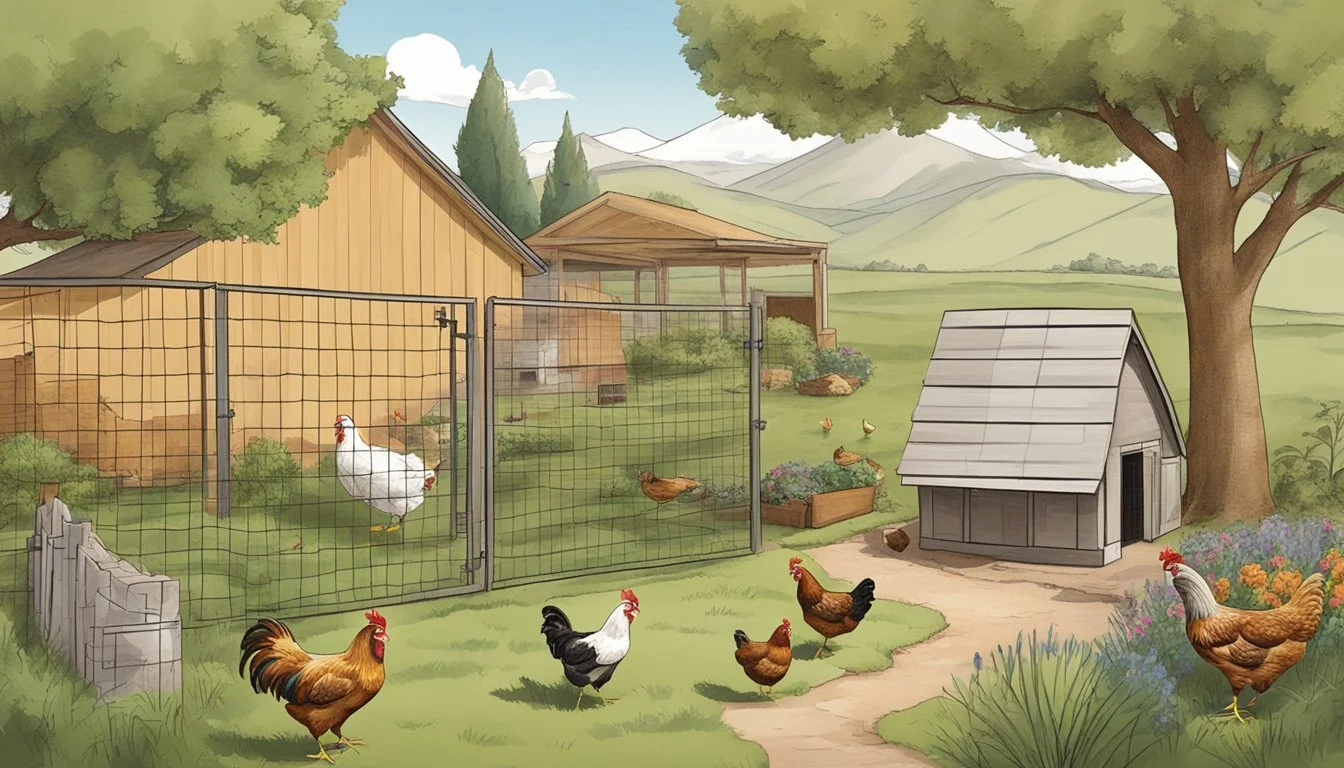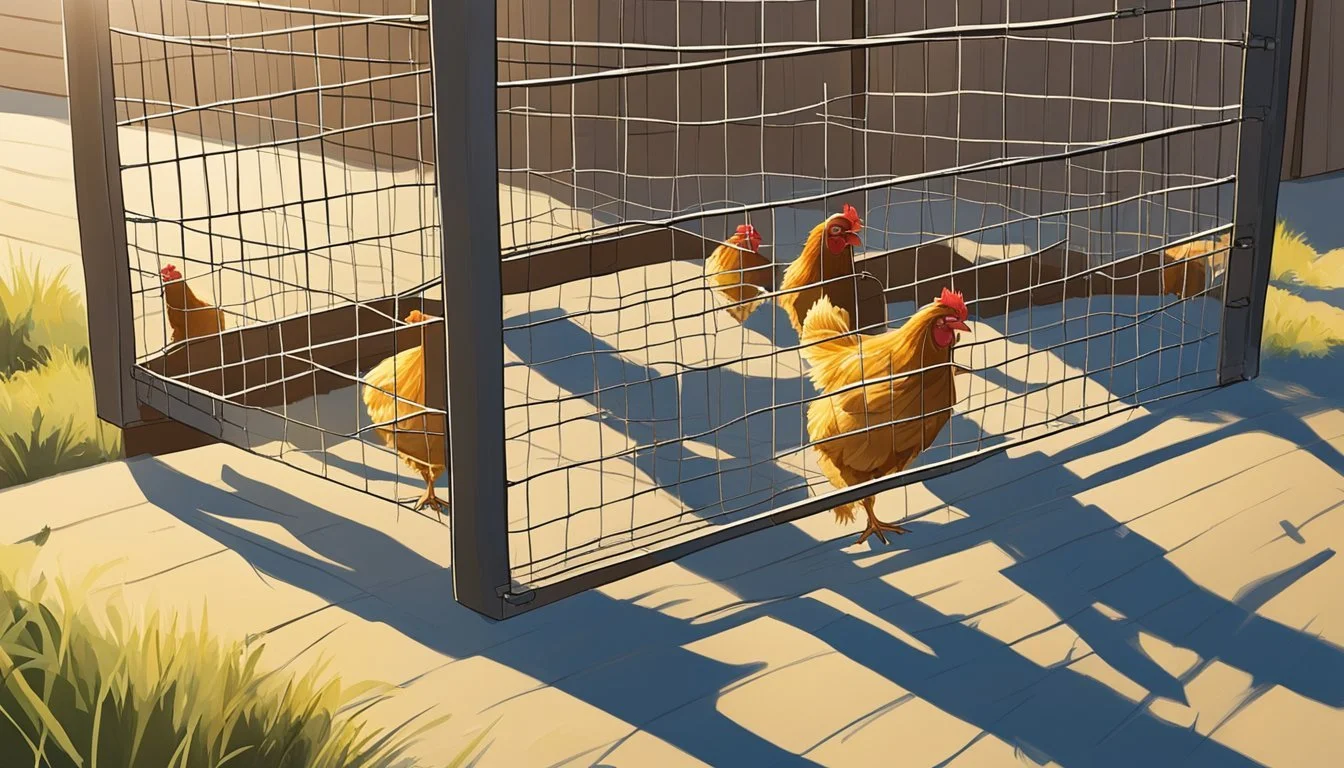Raising Backyard Chickens in Lehi, UT
Essential Tips for Beginners
Raising backyard chickens has become increasingly popular in many communities across the United States, appealing to those who desire fresh eggs, natural pest control, and the joy of keeping these lively birds. In Lehi, Utah, this trend is no different. Enthusiasts within the city seek to enjoy the benefits of having their own flock but must navigate specific regulations designed to maintain harmony within residential areas while allowing for such personal agriculture.
Lehi's ordinances articulate clear guidelines for residents interested in raising chickens on their property. It's essential for prospective and current chicken owners to understand these rules to ensure they are in compliance with local laws. The regulations in Lehi permit the keeping of chickens within certain zoning districts, with specific stipulations regarding the number of chickens allowed, coop placement, and property size requirements.
Knowledge about local laws is just as important as understanding how to care for the chickens themselves. Homeowners' associations may have additional rules, so it's crucial for residents to check both city ordinances and HOA covenants before setting up a backyard coop. This preemptive research helps to prevent any future disputes and also promotes a peaceful community where chicken raising can be a rewarding experience for all involved.
Understanding Local Chicken Laws
In Lehi, Utah, aspiring poultry owners must adhere strictly to local zoning and chicken ordinances. Familiarity with the specifics of these laws is essential for legal and hassle-free chicken rearing.
Lehi Zoning and Property Requirements
In Lehi, the keeping of roosters is strictly regulated. They are permitted only in the A-5, TH-5, and A-1 Districts, as well as on properties of one acre or more in RA-1 and R-1-22 Districts. For chicken coops, there is a clear requirement: they must be located at least 30 feet away from any neighboring dwelling or building used for human occupancy.
Chicken Ordinance in Salt Lake City and Provo
While Lehi has its own specific regulations, the surrounding cities have their ordinances. For example, within Salt Lake City limits, chickens are allowed but are subject to local laws. Provo has similar rules that are specific to its jurisdiction. Poultry owners need to consult their local government to ensure compliance with the respective ordinances.
Navigating RA-1 Zoning for Backyard Chickens
In RA-1 zones, residents can maintain up to 8 class four animals, which includes chickens. However, the presence of other pets such as dogs and cats could affect this number, typically reducing the allowed chicken count by the number of other pets. It is also required that coops be placed 30 feet from neighboring homes and 25 feet from the property lines.
Choosing the Right Chicken Breed
When selecting a chicken breed for a backyard flock in Lehi, UT, prospective poultry keepers should focus on egg-laying capabilities, disease resilience, and the personality traits of various breeds. It is important to find a balance that fits with the local climate conditions and backyard environments.
Egg Laying Capabilities
Lohmann Browns: Known for their prolific egg-laying abilities, Lohmann Browns can lay over 300 eggs per year. This makes them a practical choice for those prioritizing egg production.
Leghorns: These chickens are another high-producing breed, famous for their white eggs. A single Leghorn hen can lay up to 280 eggs annually.
Disease Resilience
Chickens face various disease risks, and certain breeds have developed stronger resilience. For instance:
Leghorns: Not only are they excellent layers, but Leghorns also have a strong constitution against common poultry ailments.
Disease resilience should be a consideration as it impacts not just the health of the birds, but also the stability of egg production and overall maintenance.
Temperament and Compatibility
The temperament of a chicken breed affects flock dynamics and the ease of care. Leghorns are known to be more flighty and prefer to keep to themselves.
Consideration of breed temperament is crucial for maintaining a harmonious backyard habitat and ensuring a pleasant experience for both the chickens and their keeper.
Constructing a Secure Chicken Coop
Before constructing a chicken coop in Lehi, Utah, builders must adhere to local ordinances and focus on creating a structure that provides safety, comfort, and space for the backyard chickens.
Planning the Layout and Size
When planning a chicken coop, it is important to consider the available space and local regulations. Coops should be located at least 30 feet from neighboring dwellings. The size of the coop is dictated by the number of chickens; a general rule is to provide 2-3 square feet per chicken inside the coop, and about 8-10 square feet in the outdoor run.
Incorporating Ventilation and Nesting Boxes
Adequate ventilation is crucial to maintaining a healthy environment inside the coop. Builders should ensure that there are multiple vent openings strategically placed to allow for cross-ventilation without causing drafts directly on the birds. Nesting boxes should be accessible and cozy, with one box for every three to four hens, positioned in a darker corner of the coop to provide a sense of security.
Ensuring Safety from Predators
To protect chickens from predators, the coop must be designed with security in mind:
Walls and Flooring: Use sturdy materials that cannot be easily compromised.
Secure Latches: Install locks and latches that are difficult for predators to manipulate.
Fencing: Surround the coop with fencing buried at least 12 inches underground to deter digging predators.
Roofing: Ensure the roof is well-constructed to prevent entry from above.
By following these guidelines, one can build a coop in Lehi that is secure, comfortable, and in compliance with local regulations.
Essentials of Chicken Care
Raising backyard chickens in Lehi, UT requires dedication to their diet, water supply, and living conditions to ensure their well-being and productivity.
Feeding Your Flock the Right Diet
Proper nutrition is vital for the health and egg production of backyard chickens. Chicken feed forms the core of their diet, and it should be balanced with carbohydrates, proteins, vitamins, and minerals. Typically, a commercial pellet or crumble feed is recommended, as it is specifically formulated for the nutritional needs of chickens. Lehi residents can also supplement their chickens' diets with grains and occasional treats such as vegetables and fruits, but these should not exceed 10% of the bird's daily intake.
Daily Feeding Guidelines:
Chicks (0-8 weeks): Starter feed with 18-20% protein.
Growers (8-20 weeks): Grower feed transitioning to 16% protein.
Layers (20+ weeks): Layer feed with 16-18% protein and additional calcium for shell production.
Chicken feeders should be used to provide constant access to food and should be placed above ground level to prevent contamination.
Water Supply Management
Chickens require a consistent and clean water supply to stay hydrated and healthy. Water intake is critical for temperature regulation and digestion in chickens. Lehi residents should ensure that their chickens have access to fresh water at all times, changing it daily to prevent the growth of harmful bacteria. Automated watering systems can be an effective way to maintain a continual supply without frequent manual intervention.
Water Supply Checklist:
Check water levels multiple times a day during hot weather or if the flock size increases.
Water should be positioned away from feed to minimize contamination.
Clean and refill water containers daily.
Maintaining Cleanliness and Health
A clean environment is non-negotiable for the health of backyard chickens. Coops should be cleaned regularly, with waste removed and old bedding such as clean straw replaced to prevent the outbreak of diseases. A thorough cleaning of the coop should occur frequently, and any signs of pests or droppings should be addressed immediately.
Cleaning Essentials:
Nest boxes should be filled with soft, clean bedding to encourage laying and to keep eggs clean.
The coop floor should be lined with an absorbent material, such as straw or wood shavings, and changed out regularly.
Ensure proper ventilation in the coop to reduce ammonia levels and moisture.
A healthy flock is a productive flock. Consistency in providing the right diet, a steady water supply, and a clean living environment will lead to a thriving backyard chicken community in Lehi, UT.
Day-to-Day Management of Your Flock
Maintaining a healthy and productive backyard chicken flock in Lehi, UT, requires consistent daily management. This includes routine inspections for health and safety, as well as managing egg collection and storage effectively.
Routine Inspections for Health and Safety
Every day, the chicken run should be checked for potential hazards and signs of disease. Owners should look for symptoms such as lethargy, changes in eating habits, and abnormal droppings, which could indicate health issues. It's crucial to ensure the chickens have access to fresh water and feed, and the coop is secure from predators.
Inspecting and maintaining physical structures is essential; fencing should be robust and free from gaps. Any signs of disease or injury require immediate attention, and a veterinarian should be consulted if serious conditions arise. A methodical approach to daily inspections not only prevents disease but also maximizes the overall safety and well-being of the flock.
Managing Egg Collection and Storage
Egg collection should be a daily task to ensure freshness and to decrease the likelihood of the eggs becoming dirty or damaged. Once collected, eggs should be:
Cleaned: Gently wiped to remove any debris.
Categorized: Check for cracks or irregularities.
Stored: Place eggs in a cool, dry place, ideally within a refrigerator.
Eggs should be stored pointed end down to maintain their freshness. The temperature for storage should be constant to prevent bacterial growth—usually between 35°F and 40°F. It's not recommended to wash eggs immediately after collection as it can remove the protective bloom, but any noticeably soiled eggs can be cleaned with warm water and a soft cloth or brush.
Understanding the Costs and Equipment
Raising chickens in one's backyard in Lehi, Utah, requires an understanding of both the initial investment and the ongoing expenses for maintenance. Equipments are key components in the process, influencing both functionality and costs.
Initial Investment for Raising Chickens
The first step in raising chickens involves securing the necessary equipment and housing. The cost of a basic chicken coop ranges from $200 to $500 and varies based on size and features. One needs to consider Lehi's zoning laws, which prescribe that chicken coops must be at least 30 feet away from any neighboring dwellings. Chickens themselves have a modest cost, typically $3 to $5 per chick.
A typical list of equipment for starting up may include:
Chicken coop: With a variety of designs available, one must select a coop that provides sufficient space, ventilation, and protection from predators.
Feeder and Waterer: Essential for daily nourishment; the recommendation is to provide 1 quart of water per 4 chickens.
Electricity: Necessary to maintain temperatures and lighting, especially during colder months.
Bedding: Pine shavings or straw can serve as low maintenance options for coop flooring.
Ongoing Expenses for Maintenance
After the initial setup, there will be continuous costs associated with raising chickens.
Monthly maintenance may involve:
Feed: Chickens require a regular supply of feed, which can usually be purchased from a local feed store.
Utilities: The use of electricity for lighting and heating will contribute to monthly expenses.
Cleaning supplies: To maintain a hygienic environment, one must invest in cleaning the coop and replenishing bedding materials.
In summary, individuals must factor in both upfront and recurring costs when planning to raise chickens in their backyard. By being well-informed, they can ensure their chickens are healthy, and their investment is sound.
Dealing with Potential Challenges
When raising backyard chickens in Lehi, Utah, owners may encounter challenges such as noise and odor complaints, and threats from theft and vandalism. Addressing these issues proactively can help ensure a harmonious and secure environment for both the chickens and the community.
Handling Noise and Odor Complaints
Noise from roosters can lead to complaints from neighbors, especially in areas where houses are in close proximity. In Lehi, the keeping of roosters is permitted in certain zoning districts such as A-5, TH-5, and A-1, and on properties of one acre or more in the RA-1 and R-1-22 districts. If keeping roosters, one should consider their roosters’ crowing patterns and employ soundproofing techniques such as:
Dense vegetation around the coop
Specially designed coop structures that muffle sound
Odor issues can arise from inadequately managed coops. To prevent this, maintain regular cleaning schedules, and ensure proper ventilation. Additionally, it’s vital to:
Locate coops at least 30 feet away from any neighboring dwelling
Implement waste management practices, like composting chicken manure
Securing Against Theft and Vandalism
Protection against theft and vandalism is crucial for maintaining the safety and well-being of backyard chickens.
Preventative Measures:
Secure fencing and locks to deter human trespassers
Durable coop construction to resist tampering
Motion-sensor lighting to illuminate the area and deter would-be vandals
Predators such as dogs, hawks, rats, and raccoons can also pose a threat. Employ strategies like:
Enclosed runs with covered tops to protect against aerial predators like hawks
Raising coops off the ground and using hardware cloth to deter rats and raccoons
Strengthening coop security at night when most predators are active
Properly addressing these potential challenges helps not only in maintaining the health and safety of the backyard flock but also in preserving the tranquility of the Lehi community.
Community Engagement and Legal Considerations
Creating a successful backyard chicken flock in Lehi, Utah requires an understanding of local regulations and positive relationships with the community. This section provides a detailed overview of how to educate neighbors about your activities as a farmer, build supportive connections, and stay abreast of local ordinances that affect your poultry endeavors.
Educating Neighbors and Building Relationships
Fostering good relations with neighbors is crucial when raising a backyard flock. It is recommended that farmers proactively communicate with those living nearby to mitigate any concerns regarding the addition of up to 15 chickens. Sharing plans about coop placement, discussing daily maintenance routines, and addressing potential noise or odor issues upfront can help prevent misunderstandings and foster a supportive environment for the chickens and the community.
Key Points to Share with Neighbors:
Number of chickens being raised and the absence of roosters to reduce noise concerns.
Measures taken to keep the coop clean and minimize odors.
Benefits to the community, such as access to fresh eggs and educational opportunities for children and adults.
Staying Updated on Changes in Local Regulations
Lehi's local laws stipulate specific conditions for owning a backyard flock. It's the responsibility of the chicken keeper to remain informed about current regulations to ensure compliance. As of the last update, in certain zoning districts, such as RA-1, residents are allowed up to 8 class four animals, which could include chickens. It's imperative to understand that coops must be at least 30 feet away from neighboring dwellings.
Regulatory Checklist for Lehi Chicken Farmers:
Confirm the number of chickens permitted on your property.
Regularly check Lehi City's official website or contact city officials for any updates to ordinances.
Adhere to construction guidelines for coops and runs, considering distances from neighboring properties.
By consulting with neighbors and closely monitoring any shifts in local ordinances, farmers can maintain a backyard flock that aligns with both the legal and social frameworks of Lehi.
The Future of Urban Chicken Farming
Urban chicken farming in Lehi, Utah, reflects a broader movement towards sustainability and food independence. The prevalence of backyard chickens is expected to grow due to increased interest in locally-sourced food and the empowerment of personal food production.
Projected Trends
Sustainability Initiatives: Cities may adopt more comprehensive guidelines to facilitate urban chicken farming, focusing on eco-friendly practices and waste management.
Technological Innovation: Advancements in coop design are anticipated, emphasizing compact and efficient structures suitable for small urban spaces.
Regulation Adaptation: Local ordinances, like those in Lehi, could evolve to balance the benefits of raising chickens with neighborhood dynamics and land usage.
Challenges and Adaptations
Space Constraints: Urban chicken farmers will likely employ creative strategies to optimize limited space without compromising animal welfare.
Community Education: As interest grows, informational resources regarding the care of backyard chickens and best practices may become more readily available.
Health Considerations: The importance of disease prevention measures and regular health checks for backyard flocks will garner attention to mitigate risks associated with avian diseases.
Engagement and Community Impact
Increased Participation: Community programs may emerge, promoting engagement and shared learning experiences regarding urban chicken farming.
Local Economy Support: A shift towards supporting local feed and supply stores is probable as individuals invest in the necessary equipment and materials for raising chickens.
In essence, the future of raising backyard chickens in urban settings like Lehi remains bright, with ongoing adaptation to local frameworks and a strong community interest in responsible and sustainable living.
Additional Resources
For residents of Lehi, Utah, who are interested in or currently raising backyard chickens, there are several resources available to assist with best practices and local compliance:
Utah Department of Agriculture and Food: They require owners with 3 or more chickens to register as backyard poultry owners. Their website offers guidelines and regulations that are essential for keeping chickens in Utah.
Utah Farm Bureau: A comprehensive resource that offers guidance on how to start and maintain a backyard chicken coop effectively. The bureau provides tips on everything from selecting laying hens to ensuring their health and productivity.
Utah State University Extension: The Extension provides educational materials and workshops on raising chickens. They offer information about various chicken breeds suitable for backyard flocks and advice on caring for laying hens.
Local Chicken Legislation Information: It is important to be aware of local ordinances in Lehi. For example, keeping roosters is restricted to specified zoning districts and coops must be located at least 30 feet from neighboring dwellings.
Here is a concise table summarizing the entities to consult for further information:
Entity Contact/Resources Utah Department of Agriculture and Food Website Utah Farm Bureau Website Utah State University Extension Website Local Government Offices Check the latest Lehi, UT ordinances
Residents should consult these entities for detailed insights into chicken breeds best suited for the region, care for laying hens, coop maintenance, and compliance with local laws.
Conclusion
Raising backyard chickens in Lehi, Utah requires homeowners to adhere to specific municipal ordinances. In designated zones, such as A-5, TH-5, and A-1, as well as properties over one acre in RA-1 and R-1-22 districts, residents may keep roosters. However, coops must be placed a minimum of 30 feet from any neighboring homes or human-occupied buildings.
Before starting a backyard chicken flock, they should check with local laws and homeowner association covenants. This ensures compliance and avoids any potential legal issues. The number of chickens allowed, as well as property line distance and housing specifications, may also be regulated.
Residents in the RA-1 zone are entitled to a maximum of eight class four animals, which could translate to eight chickens if no other pets like dogs or cats are present. They should take note of their specific zoning to understand their allowances and restrictions, such as rooster ownership and coop placement.
It's essential for potential chicken owners in Lehi to do their research before beginning their poultry endeavors. This includes understanding the costs, spatial needs, and responsibilities involved in raising chickens. By being well-informed and compliant with local ordinances, residents can ensure a harmonious and successful experience with backyard chickens.











